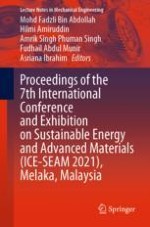This book gathers the proceedings of the 7th International Conference and Exhibition on Sustainable Energy and Advanced Materials (ICE-SEAM), held on November 2021, a virtual conference organized in Melaka, Malaysia. It focuses on two relatively broad areas—advanced materials and sustainable energy—and a diverse range of subtopics:
Advanced materials and related technologies: liquid crystals, semiconductors, superconductors, optics, lasers, sensors, mesoporous materials, nanomaterials, smart ferrous materials, amorphous materials, crystalline materials, biomaterials, metamaterials, composites, polymers, design, analysis, development, manufacturing, processing and testing for advanced materials.
Sustainable energy and related technologies: energy management, storage, conservation, industrial energy efficiency, energy-efficient buildings, energy-efficient traffic systems, energy distribution, energy modeling, hybrid and integrated energy systems, fossil energy, nuclear energy, bioenergy, biogas, biomass geothermal power, non-fossil energies, wind energy, hydropower, solar photovoltaic, fuel cells, electrification, and electrical power systems and controls.
